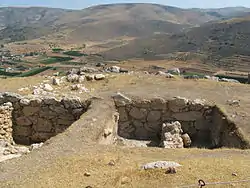Midea (Argolid)
Midea (Ancient Greek: Μιδέα)[1] or Mideia (Μίδεια)[2] was a city of ancient Argolis.

Mythology and proto-history
Midea was originally called Perseuspolis (Περσέως πόλις),[3] and is mentioned by Pseudo-Apollodorus in connection with this hero.[4] It was said to have derived its name from the wife of Electryon, and was celebrated as the residence of Electryon and the birthplace of his daughter Alcmena.[5][6] But it is mentioned in the earliest division of the country, along with the Heraeum and Tiryns, as belonging to Proetus.[7] It was the residence of Hippodameia in her banishment.[2]
History
It was destroyed by Argos, probably at the same time as Tiryns, soon after the Greco-Persian Wars.[8][1] Strabo describes Midea as near Tiryns; and from its mention by Pausanias, in connection with the Heraeum and Tiryns, it must be placed on the eastern edge of the Argeian plain; but the only clue in the ancient authors to its exact position is the statement of Pausanias, who says that, returning from Tiryns into the road leading from Argos to Epidaurus, "you will reach Mideia on the left."[9]
Site and remains

The remains of Midea, that of a Bronze Age citadel, stand above the village of the same name in the Argolid. The citadel is one of the largest and best preserved Mycenaean citadels. A tholos tomb and cemetery of chamber tombs at nearby Dendra is associated with the site.
Excavations were started by the Swedish archaeologist Axel W. Persson and have been continued regularly by the Swedish Institute at Athens and published in the journal Opuscula.[10][11][12][13][14]
References
- Strabo. Geographica. viii. p.373. Page numbers refer to those of Isaac Casaubon's edition.
- Pausanias. Description of Greece. 6.20.7.
- Stephanus of Byzantium. Ethnica. s.v. Μίδεια.
- Bibliotheca (Pseudo-Apollodorus), 2.4.4.
- Pausanias. Description of Greece. 2.25.9.
- Schol. ad Pind. Ol. 7.49.
- Pausanias. Description of Greece. 2.16.2.
- Pausanias. Description of Greece. 8.27.1.
- Pausanias. Description of Greece. 2.25.9.
- "Excavations in Midea 2006". Editorial Committee of the Swedish Institutes at Athens and Rome. 2008-12-02. doi:10.30549/opathrom-01-02. Retrieved 2021-01-08.
- "Excavations in Midea 2007". Editorial Committee of the Swedish Institutes at Athens and Rome. 2009-12-02. doi:10.30549/opathrom-02-02. Retrieved 2021-01-08.
- "Excavations in Midea 2008–2009". Editorial Committee of the Swedish Institutes at Athens and Rome. 2010-12-02. doi:10.30549/opathrom-03-02. Retrieved 2021-01-08.
- "Textile tools from the East Gate at Mycenaean Midea, Argolis, Greece". Editorial Committee of the Swedish Institutes at Athens and Rome. 2016-12-02. doi:10.30549/opathrom-09-08. Retrieved 2021-01-08.
- "A Mycenaean pictorial vase from Midea". Editorial Committee of the Swedish Institutes at Athens and Rome. 2020-11-02. doi:10.30549/opathrom-13-04. Retrieved 2021-01-08.
![]() This article incorporates text from a publication now in the public domain: Smith, William, ed. (1854–1857). "Mideia". Dictionary of Greek and Roman Geography. London: John Murray.
This article incorporates text from a publication now in the public domain: Smith, William, ed. (1854–1857). "Mideia". Dictionary of Greek and Roman Geography. London: John Murray.